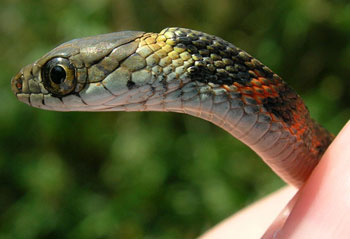A new study shows that the Asian snake Rhabdophis tigrinus becomes poisonous by sequestering toxins from its prey which consists of toxic toads. The research is published in the current issue of The Proceedings of the National Academy of Sciences.
Analyzing differences between snakes living on toad-rich and toad-deficient islands in Japan, Researchers lead by Deborah A. Hutchinson of Old Dominion University in Norfolk, Virginia, found that Japanese grass snake or Yamakagashi, as the snake is known locally, did not manufacture its own venom, but instead relied on that found in toxic toads:
-
The researchers found that snakes living on Japan’s toad-free island of Kinkazan lacked the toad’s toxic bufadienolide compounds completely. Snakes from Ishima, where toads are plentiful, had high levels of bufadienolides. R. tigrinus from Honshu, where toad numbers vary, displayed a wide range of bufadienolide concentrations. Feeding R. tigrinus hatchlings toad-rich and toad-free diets confirmed these results.
The study also found that snake mothers with high concentrations of the toxin are able to pass bufadienolide toxin on their offspring helping protect them from predators.

Juvenile Asian snake Rhabdophis tigrinus from the toad-rich island of Ishima, Japan. A large ridge, formed by underlying toxin-containing nuchal glands, is evident on the back of the neck. Image courtesy of Deborah A. Hutchinson. |
The Yamakagashi stores the sequestered toxins in “a series of paired structures known as nuchal glands in the dorsal skin of the neck,” according to the researchers. When threatened the snake takes a defensive position that exposes the toxin-containing nuchal glands to predators.
While sequestering defensive toxins from prey is unusual among terrestrial vertebrates, it is not unknown. Research published in recent years by John W. Daly, Ralph Saporito, Valerie C. Clark, and others have showed that poison dart frogs (Dendrobates species) and their Madagascar counterparts, the Mantella frogs, sequester toxic skin chemicals, called alkaloids, from the ants they eat. These alkaloids protect the frogs from predation. Similarly, some garter snakes are known to store tetrodotoxin from ingested newts while birds in New Guinea appear to sequester poisons from insects.
Citation: “Dietary sequestration of defensive steroids in nuchal glands of the Asian snake Rhabdophis tigrinus” by Deborah A. Hutchinson, Akira Mori, Alan H. Savitzky, Gordon M. Burghardt, Xiaogang Wu, Jerrold Meinwald, and Frank C. Schroeder
Editor’s note: This article originally characterized the toads as “venomous”, which is inaccurate. We changed the wording to “toxic” after a reader noted the error.














